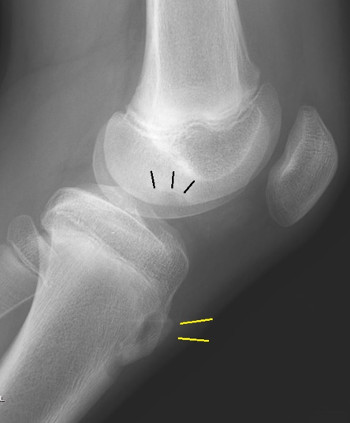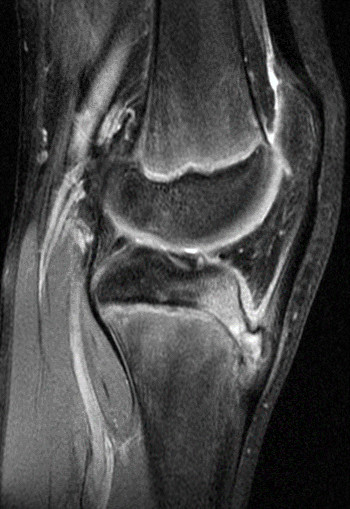
12-year-old male with knee pain at tibial tubercle (yellow lines) and osteochondritis dissecans (OCD) of femur (black lines. Children with Osgood Schlatter’s disease are at risk for other conditions such as OCD because they are usually very active.
Description
Osgood-Schlatter’s disease (tibial tubercle apophysitis) is a form of knee pain found in growing children. The pain is over a bump of bone in the front of the knee called the tibial tubercle. The tibial tubercle sits at the top of the tibia (shin) bone where the patellar tendon attaches. This tendon attaches the kneecap to the shinbone. The pain from Osgood-Schlatter’s comes from a pulling of this tendon on the bone and the growth plate underneath. This condition most often occurs during growth spurts when bones, muscles, tendons, and other structures are growing. The muscle in the front of the thigh (quadriceps muscle) attaches to the kneecap (patella) and to the tibial tubercle through the patellar tendon. This tug-of-war concentrates at the tibial tubercle in growing children and teenagers. Children who participate in running and jumping sports are at an increased risk for this condition. However, less active adolescents may also experience this problem
When a child straightens their knee, the quadriceps muscles pull on the patellar tendon, which pulls on the tibial tubercle. This repetitive traction on the tubercle can to inflammation of the growth plate. The patellar tendon remains strong, but the attachment at the growth plate can be weak and slowly separate. As the growth plate tries to heal, extra bone will form. This may be noticed as a bump at the front of the knee and may be seen on x-rays.
Symptoms
Symptoms include pain and swelling. Pain is typically increased with activity and decreased with rest. The painful spot is over the bone at the top of the shinbone that is the attachment of the patellar tendon.
Examination
On examination, your doctor will feel the area of bone that is prominent (sticks out). Your doctor will also examine the rest of your knee to be sure there are no other issues that could cause your pain.

MRI of a patient showing large amount of inflammation (white area) at tibial tubercle due to traction forces (MRI was obtained to evaluate OCD of femur).
X-rays and Tests
Your doctor may choose to take an x-ray of your knee to look at the painful bump. The blue arrow points at the prominent bone (tibial tubercle). An MRI scan is usually not necessary for the diagnosis of Osgood-Schlatter’s disease.
Treatment
Once the patient stops growing, around the age of 14 for girls and 16 for boys, this problem almost always gets better. In the meantime, rest, icing, stretching, and strengthening of the knee are all appropriate options to ease the knee pain. Some patients will get some relief with simple knee sleeves or patellar tendon straps. You should be evaluated by a pediatric Orthopaedic surgeon If the pain does get worse or you have a limp with walking
Outcomes (Prognosis/Expectations)
The knee pain almost always stops once the patient is done growing, but the bump on the knee may be permanent.. Removal of the bump of bone (ossicle) is rarely necessary. On rare occasions, the pain and inflammation worsen and the growth plate can give way with a jumping injury. A severe fracture can occur which may require surgery to repair.
More Information
Condition QR Code:'


 POSNA.org
POSNA.org


